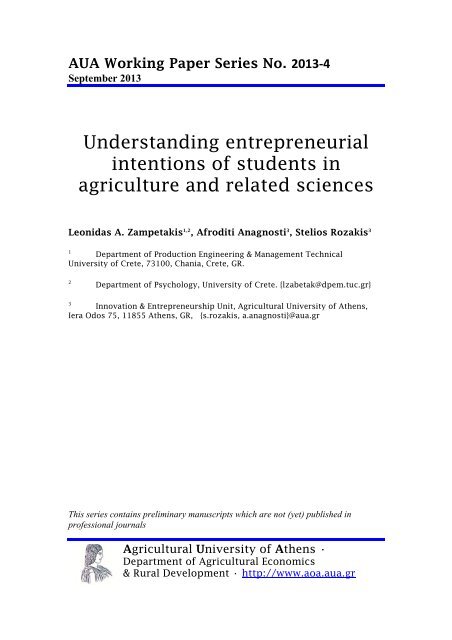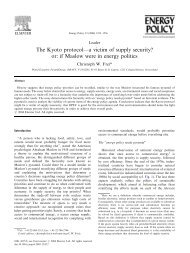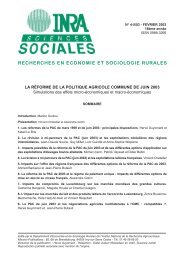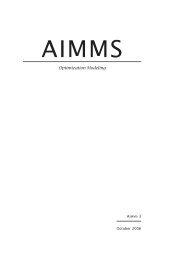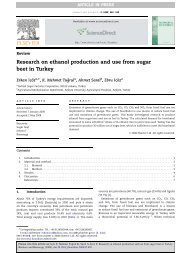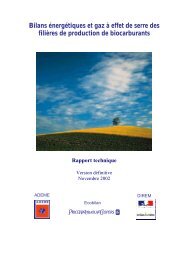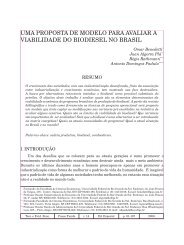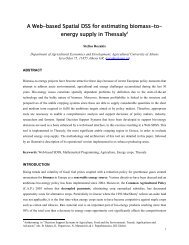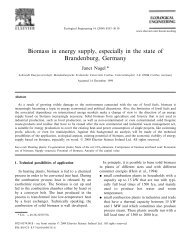Understanding entrepreneurial intentions of students in agriculture ...
Understanding entrepreneurial intentions of students in agriculture ...
Understanding entrepreneurial intentions of students in agriculture ...
You also want an ePaper? Increase the reach of your titles
YUMPU automatically turns print PDFs into web optimized ePapers that Google loves.
1. INTRODUCTIONEntrepreneurship and <strong>entrepreneurial</strong> culture are receiv<strong>in</strong>g an <strong>in</strong>creased amount <strong>of</strong>attention <strong>in</strong> both academic research and practice. Entrepreneurship is l<strong>in</strong>ked with value creationand as such, it is thought to have a significant impact on economic growth, cont<strong>in</strong>uous bus<strong>in</strong>essrenewal, and employment. Empirical research supports positive l<strong>in</strong>ks between <strong>entrepreneurial</strong>activity, economic growth and <strong>in</strong>novation. Thus, it is apparent why there is an <strong>in</strong>creased<strong>in</strong>terest <strong>in</strong> educational programmes designed to encourage entrepreneurship and to provide abetter <strong>in</strong>frastructure for bus<strong>in</strong>ess start-ups [Kuratko, 2005]. However, the role <strong>of</strong>entrepreneurship and <strong>in</strong>novation has not been given much emphasis <strong>in</strong> the field <strong>of</strong> universityagricultural education [Knudson, et al, 2004]. Agricultural education has to prepare the futuregeneration <strong>of</strong> leaders, researchers, pr<strong>of</strong>essionals, technicians and last but not least, <strong>in</strong>novativefarmers, who collectively can meet the challenges <strong>of</strong> global food security. Although emphasisis placed <strong>in</strong> the cont<strong>in</strong>uous education <strong>of</strong> farmers, it is agricultural university <strong>students</strong>, <strong>in</strong>comparison to <strong>in</strong>dividuals without university education, who are more likely to pursue selfemploymentand start a bus<strong>in</strong>ess <strong>in</strong> the agrifood sector which has significant impact oneconomic growth (Rob<strong>in</strong>son & Sexton, 1994). Agricultural universities can work as facilitatorfactors towards <strong>students</strong> bus<strong>in</strong>ess start ups through the <strong>in</strong>troduction <strong>of</strong> entrepreneurshipresearch and education programmes.Behavior and decision mak<strong>in</strong>g <strong>of</strong> agricultural <strong>students</strong> for participat<strong>in</strong>g <strong>in</strong> <strong>entrepreneurial</strong>activities can be addressed by their <strong>entrepreneurial</strong> <strong><strong>in</strong>tentions</strong>. The importance <strong>of</strong><strong>entrepreneurial</strong> <strong><strong>in</strong>tentions</strong> as antecedents <strong>of</strong> planned behavior (such as found<strong>in</strong>g a newbus<strong>in</strong>ess) has been emphasized <strong>in</strong> recent years (e.g. Krueger, et al., 2000; Peterman andKennedy, 2003). Accord<strong>in</strong>g to Thompson (2009, p.676) <strong>entrepreneurial</strong> <strong>in</strong>tention is “a selfacknowledgedconviction by a person that they <strong>in</strong>tend to set up a new bus<strong>in</strong>ess venture andconsciously plan to do so at some po<strong>in</strong>t <strong>in</strong> the future”.In the present paper, we use the Theory <strong>of</strong> Planned Behavior-TPB (Ajzen, 1991) toempirically assess factors affect<strong>in</strong>g agricultural <strong>students</strong>’ <strong>entrepreneurial</strong> <strong>in</strong>tent. Furthermore,<strong>in</strong> l<strong>in</strong>e with recent theoretical and empirical studies, about the potential role <strong>of</strong> emotions <strong>in</strong>entrepreneurship (Baron, 2008) we <strong>in</strong>vestigated the role <strong>of</strong> anticipated emotional ambivalencefrom entrepreneurship as a career choice (that is <strong>students</strong>’ future oriented emotions relat<strong>in</strong>g tothe expectancy <strong>of</strong> feel<strong>in</strong>g both positive and negative affect) <strong>in</strong> their <strong>in</strong>tention to start a bus<strong>in</strong>ess.2
efer to emotional states def<strong>in</strong>ed by both positive and negative emotions (Williams and Aaker,2002). Although there still exists an <strong>in</strong>terest<strong>in</strong>g controversy <strong>in</strong> the literature on whether peoplecan experience positive and negative affect at the same time we have no reasons to believe thatthis will not also be true for anticipated affect <strong>in</strong> the context <strong>of</strong> entrepreneurship, anemotionally complex process.We exam<strong>in</strong>ed <strong>students</strong>’ anticipated affect when asked to imag<strong>in</strong>e nascententrepreneurship. Nascent entrepreneurs (i.e. <strong>in</strong>dividuals that are <strong>in</strong>volved <strong>in</strong> on-go<strong>in</strong>g but notyet operational bus<strong>in</strong>ess start-up efforts <strong>in</strong> which they are go<strong>in</strong>g to be owners) engage <strong>in</strong> a widevariety <strong>of</strong> gestation activities vastly vary<strong>in</strong>g <strong>in</strong> duration and <strong>in</strong> composition, that may grouped<strong>in</strong>to different categories <strong>of</strong> behavior. In this situation no money has been <strong>in</strong>vested, no <strong>in</strong>comehas been made and the bus<strong>in</strong>ess <strong>in</strong> not a legal entity (Carter, et al., 1996).3. OVERVIEW OF STUDY AIMSThe study aimed to <strong>in</strong>vestigate the extent to which, the TPB holds for agriculturaluniversity <strong>students</strong>. Furthermore, we <strong>in</strong>vestigated the relationship between the core variables <strong>of</strong>the TPB and anticipated affective ambivalence from nascent entrepreneurship.4. MATERIALS AND METHODSWe used a cross-sectional survey design and applied a structured questionnaire to collectdata. Survey data were collected from 65 <strong>students</strong> from the Agricultural University <strong>of</strong> Athens(AUA). These <strong>students</strong> participated <strong>in</strong> the entrepreneurship program organized by theInnovation & Entrepreneurship Unit <strong>of</strong> AUA. Surveys were adm<strong>in</strong>istrated to <strong>students</strong>’ class atthe beg<strong>in</strong>n<strong>in</strong>g <strong>of</strong> the programme (October 2012). In sum, the sample consisted <strong>of</strong> 29 male<strong>students</strong> (44.6%), the mean sample age was 24.11 years (SD = 2.61 years). Six participants(9.2%) were postgraduate <strong>students</strong>. Thirty three percent <strong>of</strong> the participants reported that one <strong>of</strong>their parents owned full time bus<strong>in</strong>ess most <strong>of</strong> the time, while they were grow<strong>in</strong>g up, almosteighty percent reported that they know an entrepreneur <strong>in</strong> their close environment. It isnoteworthy that various discipl<strong>in</strong>es <strong>of</strong> agricultural related sciences are represented <strong>in</strong> theparticipants, namely Crop Science (12 <strong>students</strong>), Biotechnology (9), Food Science (9),Agricultural Economics and Rural Development (31) and Animal Science (4).The questionnaire conta<strong>in</strong>ed constructs (i.e. variables) that were assessed with self-reportmeasures based on multi-item scales. Specifically, we assessed <strong>students</strong>’ <strong>entrepreneurial</strong> <strong>in</strong>tent(INT) us<strong>in</strong>g the scale orig<strong>in</strong>ally developed by Thompson (2009). Attitudes towards5
entrepreneurship (ATT), subjective Norm (SN) and perceived behavioural control (PBC) wereassessed us<strong>in</strong>g the five, three and five item scales respectively from L<strong>in</strong>an and Chen (2009).Anticipated Positive (PA) and Negative Affect (NA) were assessed us<strong>in</strong>g 20 items (ten positiveand ten negative) from the Positive Affect and Negative Affect Schedule (PANAS) (Watson etal., 1988). F<strong>in</strong>ally, we used the Gradual Threshold Model (GTM) <strong>of</strong> ambivalence and the GTMformula suggested by Priester and Petty (1996), to assess anticipated affective ambivalence(AMB). Responses to the ATT, INT and PBC items were made on 7-po<strong>in</strong>t Likert-type scales (1= strongly disagree, 7 = strongly agree). For SN, PA and NA items responses were made on 5-po<strong>in</strong>t Likert-type scales. Cronbach’s reliability coefficients for the scales were acceptable(range from 0.61 to 0.93).We used path analysis with INT as the dependent variable. Path analysis is a multivariatestatistical technique and like multiple regression, is used for estimat<strong>in</strong>g the relationshipbetween dependent and <strong>in</strong>dependent variables. The ma<strong>in</strong> advantage <strong>of</strong> path analysis is thatoverall model goodness <strong>of</strong> fit <strong>in</strong>dexes can be estimated to exam<strong>in</strong>e the model-data fitdiscrepancy and that parameter estimates are computed simultaneously. Analysis <strong>of</strong> MomentStructures (AMOS s<strong>of</strong>tware, version 7.0) with maximum likelihood estimation was used, forthe parameter estimation. We used several <strong>in</strong>dexes to assess model fit (Shook et al., 2004): (a)Root Mean Square Error Approximation (RMSEA): 0 = an exact fit, < 0.05 = a close fit, 0.05 –0.08 = a fair fit, 0.08 – 0.10 = a mediocre fit, and > 0.10 = a poor fit (AMOS also computes a90% confidence <strong>in</strong>terval around RMSEA); (b) Comparative Fit Index (CFI): best if above 0.9;(c) Akaike Information Criterion (AIC). For model comparisons, smaller values <strong>in</strong> AICrepresent a better fit <strong>of</strong> the model.5. RESULTS & DISCUSSIONIn Table 1, we present means, standard deviations and correlations across selectedvariables. Our results suggest that agricultural <strong>students</strong>’ <strong>entrepreneurial</strong> <strong>in</strong>tent (INT) is stronglyand positively related to attitudes towards entrepreneurship (ATT) (r = 0.70, p < 0.01, twotailed) and perceived behavioral control (PBC) (r = 0.74, p < 0.01, two tailed). SN correlatedsignificantly only with PA. Furthermore, anticipat<strong>in</strong>g positive affect from nascententrepreneurship (PA) correlates positively with all the TPB model variables, whileanticipat<strong>in</strong>g negative affect relates negatively only to PBC. This suggests that anticipat<strong>in</strong>gnegative affect relates to <strong>students</strong>’ beliefs that they not are capable <strong>of</strong> perform<strong>in</strong>g a givenbehaviour (i.e. start a bus<strong>in</strong>ess <strong>in</strong> our case).6
Table 1: Descriptive statistics and <strong>in</strong>ter-correlations for the total sample (N=65)Mean SD 1 2 3 4 5 6 71. ATT 4.83 1.48 (0.93)2. SN 3.80 0.67 0.22 (0.61)3. PBC 3.05 1.20 0.49 ** 0.17 (0.88)4. INT 3.46 1.59 0.70 ** 0.03 0.74 ** (0.92)5. PA 3.81 0.63 0.54 ** 0.25 ** 0.54 ** 0.55 ** (0.88)6. NA 1.83 0.56 0.09 -0.09 -0.24 * -0.07 -0.12 (0.81)7. AMB 3.64 1.07 0.11 -0.11 -0.25 * 0.07 -0.06 0.98 ** -Reliabilities are <strong>in</strong> parentheses*p
people <strong>in</strong> our measure <strong>of</strong> SN were close family, friends, and fellow <strong>students</strong>. SN reflects theperceived social pressure to start a firm.We believe this negative relationship between SN andINT largely echoes the current socioeconomic situation <strong>in</strong> Greece, where large sectors <strong>of</strong> theGreek population are <strong>in</strong> a state <strong>of</strong> poverty, s<strong>in</strong>ce they are not only <strong>in</strong> desperate need <strong>of</strong> the mostbasic facilities <strong>of</strong> a household but earn annually less than 60% <strong>of</strong> the median annual <strong>in</strong>come <strong>of</strong>a Greek citizen. Thus, results suggest that dur<strong>in</strong>g the Greek f<strong>in</strong>ancial crisis reference peoplehave no role to play <strong>in</strong> <strong>students</strong>’ decision to start a bus<strong>in</strong>ess. It is important to know thatparticipants had already demonstrated their <strong>in</strong>terest <strong>in</strong> entrepreneurship by choos<strong>in</strong>g theelective course on Strategic Management, <strong>in</strong> other words they are already positively biased or<strong>in</strong>terested. This could expla<strong>in</strong> some results, for <strong>in</strong>stance the remarkably high predictivecapacity <strong>of</strong> the model.Furthermore, it would be <strong>in</strong>terest<strong>in</strong>g to expand the survey group to lay <strong>students</strong>. Also theanalysis could be enriched us<strong>in</strong>g dummy variable <strong>in</strong> order to dist<strong>in</strong>guish between agriculturaldiscipl<strong>in</strong>es oriented to technical matters (crop, animal and food science and biotechnology) andagricultural economics <strong>students</strong> that counts for about half the sample population. Last but notleast two sub-groups based on <strong>entrepreneurial</strong> <strong>in</strong>fluence with<strong>in</strong> the close family could lead toclarify some f<strong>in</strong>d<strong>in</strong>gs <strong>of</strong> the analysis.6. REFERENCESAjzen, I. (1991). The theory <strong>of</strong> planned behavior. Organizational Behavior and HumanDecision Processes, 50, 179-211.Armitage, C. J., & Conner, M. (2001). Efficacy <strong>of</strong> the theory <strong>of</strong> planned behaviour: A metaanalyticreview. British Journal <strong>of</strong> Social Psychology, 40(4), 471-499.Bandura, A. (2001). Social cognitive theory: an agentic perspective. Annual Review <strong>of</strong>Psychology, 52, 1-26.Baron, R. A. (2008). The role <strong>of</strong> affect <strong>in</strong> the <strong>entrepreneurial</strong> process. Academy <strong>of</strong> ManagementReview, 32(2), 328-340.Baumgartner, H., Pieters, R., & Bagozzi, R. P. (2008). Future-oriented emotions:Conceptualization and behavioral effects. European Journal <strong>of</strong> Social Psychology,38(4), 685-696.Carter, N. M., Gartner, W. B., & Reynolds, P. D. (1996). Explor<strong>in</strong>g start-up event sequences.Journal <strong>of</strong> Bus<strong>in</strong>ess Ventur<strong>in</strong>g, 11(3), 151-166.Conner, M., & Armitage, C. J. (1998). Extend<strong>in</strong>g the theory <strong>of</strong> planned behavior: A review andavenues for further research. Journal <strong>of</strong> Applied Social Psychology, 28(15), 1429-1464.Knudson, W., Wysocki, A., Champagne, A., & Peterson, H. C. (2004). Entrepreneurship and<strong>in</strong>novation <strong>in</strong> the agri-food system. American Journal <strong>of</strong> Agricultural Economics,, 86,1330-1338.Krueger, N. F. J., Reilly, M. D., & Carsrud, A. L. (2000). Compet<strong>in</strong>g models <strong>of</strong> <strong>entrepreneurial</strong><strong>in</strong>tention. Journal <strong>of</strong> Bus<strong>in</strong>ess Ventur<strong>in</strong>g, 15, 411-432.8
Kuratko, D. F. (2005). The emergence <strong>of</strong> entrepreneurship education: Development, trends,and challenges. Entrepreneurship Theory and Practice, 29(5), 577-598.Li, Y. (2011). Emotions and new venture judgement <strong>in</strong> Ch<strong>in</strong>a. Asia Pac J Manag, 28, 277-298.L<strong>in</strong>an, F., Chen, Y. W. (2009). Development and cross-cultural application <strong>of</strong> a specific<strong>in</strong>strument to masure <strong>entrepreneurial</strong> <strong><strong>in</strong>tentions</strong>. Entrepreneurship Theory and Practice,33(3), 593-617.Peterman, N., & Kennedy, J. (2003). Enterprise education: <strong>in</strong>fluenc<strong>in</strong>g <strong>students</strong>' perceptions <strong>of</strong>entrepreneurship. Entrepreneurship Theory and Practice, 28(2), 129-144.Priester, J. R., & Petty, R. E. (1996). The gradual threshold model <strong>of</strong> ambivalence: Relat<strong>in</strong>g thepositive and the negative bases <strong>of</strong> attitude to subjective ambivalence. Journal <strong>of</strong>Personality and Social Psychology, 71(3), 431-449.Rob<strong>in</strong>son, P. B., & Sexton, E. A. (1994). The effect <strong>of</strong> education and experience on selfemploymentsuccess. Journal <strong>of</strong> Bus<strong>in</strong>ess Ventur<strong>in</strong>g, 9, 141-157.Shook, C. L., Ketchen, D. J. J., Hult, G. T. M., & Kacmar, K. M. (2004). An assessment <strong>of</strong> theuse <strong>of</strong> structural equation models <strong>in</strong> strategic management research. StrategicManagement Journal, 25, 397-404.Siemer, M., Mauss, I., & Gross, J. (2007). Same situation-different emotions: How appraisalsshare our emotions. Emotions, 7(3), 592-600.Thompson, E. R. (2009). Individual <strong>entrepreneurial</strong> <strong>in</strong>tent: Construct clarification anddevelopment <strong>of</strong> an <strong>in</strong>ternationally reliable metric. Entrepreneurship Theory andPractice, May, 669-694.Williams, P., & Aaker, J. L. (2002). Can mixed emotions peacefully coexist? Journal <strong>of</strong>Consumer Research, 28, 636-649.9
APPENDIXThe survey data were collected us<strong>in</strong>g a structured questionnaire which was completed by 65senior <strong>students</strong> at the undergraduate level <strong>in</strong> the Agricultural University <strong>of</strong> Athens (AUA).These <strong>students</strong> participated <strong>in</strong> the Unit Innovation and Entrepreneurship at the AgriculturalUniversity <strong>of</strong> Athens by attend<strong>in</strong>g the <strong>in</strong>troductory course to Entrepreneurship entitled"Strategic Plann<strong>in</strong>g <strong>in</strong> Food and Agriculture <strong>in</strong>dustry" (9th semester).The questionnaire was completed by <strong>students</strong> at three different moments: a) just before the firstlesson (time zero), b) about the middle <strong>of</strong> the course and c) at the end <strong>of</strong> the course (afterexam<strong>in</strong>ations). This paper presents the results from the first lesson. Completion <strong>of</strong> thequestionnaire was done <strong>in</strong> three consecutive moments <strong>in</strong> order to exam<strong>in</strong>e the effect <strong>of</strong> thecourse to <strong>students</strong>. At the end <strong>of</strong> the textthe questionnaire used <strong>in</strong> this <strong>in</strong>vestigation is presented.How calculated the variables <strong>of</strong> the model?The follow<strong>in</strong>g variables were used <strong>in</strong> the model: Attitude towards entrepreneurship (ATT)The variable is calculated as the average <strong>of</strong> questions B1-B5 <strong>of</strong> the questionnaire. Entrepreneurial Intention (INT)The <strong>in</strong>tention to start his own bus<strong>in</strong>ess is calculated as the average <strong>of</strong> questions B6, B9, B11,B12, B14, B15.Subjective Norms (SN)Subjective Norms determ<strong>in</strong>ed as the average <strong>of</strong> questions D1-D3.Perceived Behavioral control (PBC)Perceived behavioral control is calculated as the average <strong>of</strong> questions E1-E5.Anticipated Positive Affect (PA)The variable is calculated as the average <strong>of</strong> questions C1, C3, C5, C9, C10, C12, C14, C16,C17, C19.Anticipated Negative Affect (NA)This variable is calculated as the average <strong>of</strong> questions C2, C4, C6, C7, C8, C11, C13, C15,C18, C20.Anticipated affective ambivalence (AMB)The formula used was 5Cp – D 1/C, where C is equal to the magnitude <strong>of</strong> conflict<strong>in</strong>g reactions,D is equal to the magnitude <strong>of</strong> dom<strong>in</strong>ant reactions, p is less than 1 (0.5 <strong>in</strong> the present <strong>in</strong>stance),and a constant <strong>of</strong> 1 is added to C and D (Priester and Petty, 2001).10
RESEARCH ON THE EFFECTIVENESS OF COURSEA. GENERAL INFORMATION-IDENTITY OF RESEARCHWAVE 11. Your age:……………………2.Gender1. Male ……..2 . Female ………3. Are you:1. Undergraduate ……..2 . Postgraduate ...…..4. Your department‐‐‐‐‐‐‐‐‐‐‐‐‐‐‐‐‐‐‐‐‐‐‐‐‐‐‐‐‐‐‐‐‐‐‐‐‐‐5. Has anyone from his/her parentsown bus<strong>in</strong>ess?1. Yes2 . No6. Do you know personally anentrepreneur?1. Yes2 . No7. Have you worked as an employee<strong>in</strong> the past?1. Yes2 . NoNAME11
B. INSTRUCTIONS: Please rate each <strong>of</strong> the follow<strong>in</strong>g sentences accord<strong>in</strong>g to the degree <strong>of</strong>disagreement (closer to 1) or the degree <strong>of</strong> your agreement (Closer to 7).1 Be<strong>in</strong>g entrepreneur has more advantages thandisadvantages2 I like to make a career as an entrepreneur3 If I had the opportunity and resources I wouldstart my own bus<strong>in</strong>ess4 Be<strong>in</strong>g a entrepreneur I th<strong>in</strong>k it gave me greatsatisfaction5 Among several options,I would rather choose tobecome an entrepreneur6 I <strong>in</strong>tend to start my own bus<strong>in</strong>ess <strong>in</strong> the future7 I plan my future very carefully8 I read newspapers with bus<strong>in</strong>ess news9 Constantly look<strong>in</strong>g for bus<strong>in</strong>ess opportunities10 Read books on f<strong>in</strong>ancial matters11 Put away money to start my own bus<strong>in</strong>ess12 Read books on procedures for <strong>in</strong>itiat<strong>in</strong>g bus<strong>in</strong>ess13 I plan my f<strong>in</strong>ances very carefully14 Make plans to start my own bus<strong>in</strong>ess15 I dedicate time to learn how to create a bus<strong>in</strong>ess1 2 3 4 5 6 7C. INSTRUCTIONS: Th<strong>in</strong>k <strong>of</strong> yourself that has begun the process <strong>of</strong> runn<strong>in</strong>g his own bus<strong>in</strong>ess.So you're <strong>in</strong> the early stages <strong>of</strong> preparation without yet you get any cash <strong>in</strong>flow from thecompany's operation. I would like to record the extent to which you feel each emotion for thesituation you described.m<strong>in</strong>imal some moderate much <strong>in</strong>tense1 Interest2 Distressful3 anxious4 Upset5 Powerful6 Guilt7 Scared8 hostile9 Excited10 proud11 irascible12 alert13 shame14 <strong>in</strong>spired15 nervous16 determ<strong>in</strong>ed17 dedication18 panic19 full <strong>of</strong> energy20 afraid12
D. INSTRUCTIONS: If you decide to start your own bus<strong>in</strong>ess people <strong>in</strong> your narrow circle wouldapprove such a decision? Your answer is closer to one if not approved and closer to 5 if approvedit perfectly.1 2 3 4 51 Your family2 Your friends3 Your fellow <strong>students</strong>E. INSTRUCTIONS: Please rate each <strong>of</strong> the follow<strong>in</strong>g sentences accord<strong>in</strong>g to the degree <strong>of</strong>disagreement (closer to 1), or the degree <strong>of</strong> agreement (Closer to 7).1 It seems easy to start my own bus<strong>in</strong>ess and keep it <strong>in</strong>operation2 I'm ready to start a susta<strong>in</strong>able bus<strong>in</strong>ess3 I th<strong>in</strong>k I can deal with the process <strong>of</strong> creat<strong>in</strong>g a newbus<strong>in</strong>ess4 I know the necessary details to start my ownbus<strong>in</strong>ess5 If I start a bus<strong>in</strong>ess I would have a high probability<strong>of</strong> success.1 2 3 4 5 6 7G. DIRECTIONS: Write on a scale <strong>of</strong> 0-100 the likelihood <strong>of</strong> your own company deceiv<strong>in</strong>g thefollow<strong>in</strong>goptions:It is my <strong>in</strong>tention to create my own bus<strong>in</strong>ess:1. Directly (eg a month from now) ________________________2. Medium term (eg 6 months from now) __________________3. Long term (eg three years from now) ________________H. INSTRUCTIONS: Please rate each <strong>of</strong> the follow<strong>in</strong>g sentences accord<strong>in</strong>g to the degree <strong>of</strong>disagreement (closer to 1) or degree <strong>of</strong> your agreement (Closer to 7).1 2 3 4 5 6 7How strong would you1 describe your desire to startyour own bus<strong>in</strong>ess?2I want to start my ownbus<strong>in</strong>ess3The start <strong>of</strong> my bus<strong>in</strong>ess issometh<strong>in</strong>g I like to do13


